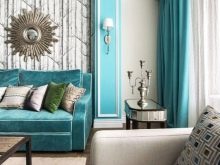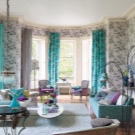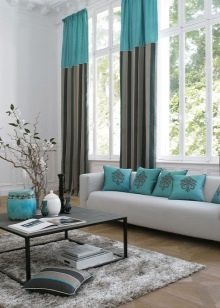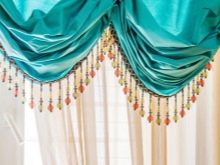Turquoise curtains in the interior of the living room

According to interior design stylists, turquoise is considered one of the most relevant dynamic tones of the palette. They try to use it in the color of furniture, decoration, wall cladding and all kinds of accessories. Among other elements of the arrangement, it is used when choosing a curtain design for a hall. What are turquoise curtains, with what and how they are combined - the material of this article will tell.



Color features
Turquoise is by no means universal and therefore requires careful selection of color contrast. Curtains in this color are bought to add an atmosphere of freshness and home comfort to the living room interior. This tone is able to fill the room with peace of mind and tranquility.
Present in the elements of the arrangement, it helps to relieve stress and fatigue. The color consists of green and blue paints, and with the predominance of each it changes its emotional color. In his palette, there are different halftones, which differ in temperature and degree of saturation.
Popular shades of turquoise include aquamarine, turquoise pearls, azure, as well as cyan, Tiffany, turquoise gray and bleached turquoise. Sometimes there may be an admixture of blue in the color.






Combination with other tones
Turquoise does not tolerate rough contrast. Among the color combinations, he has his own favorites. If this is ignored, the shade loses its sophistication and unique aesthetics. The harmonious contrast of turquoise will be:
- White;
- lactic;
- beige;
- creamy;
- light gray;
- coffee;
- sand;
- woody gray;
- silver mother-of-pearl.






Varieties
The classification of curtains for the living room is especially important to consider when choosing such an extraordinary shade as turquoise.
- by lenght panels are short to the windowsill, just below the windowsill, traditional to the floor and lying on the floor;
- by type of canvas can be solid, paired, unpaired, for one or more windows, including corner and bay windows;
- by type of textile can be dense, thin, translucent, natural, synthetic and blended;
- by color can be monochromatic, with a solid pattern over the entire surface, with a pattern along the bottom, in the form of an ombre print;
- by type of registration can be single, double and multi-layered, daytime or day-night options;
- by the method of applying the print may provide for the presence of embroidery, interwoven patterns or photo printing.






At the same time, the types of curtains for decorating living room windows can be divided into 3 categories: sliding, lifting and stationary. Sliding means a shift in one or two sides, the use of grabs. Lift ones are distinguished by the fact that they provide for a transformation system in which they open upwards, and in some modifications downwards. Others can open and close in 2 directions.
Stationary products do not provide for shift or lift. As a rule, they are created from models of different cuts, picking up and fixing them in the right places. These are not so much functional curtains as decoration of the interior of the hall.
Such designs are created from combined textiles, which allows you to add versatility and high status to the interior.



Cut type
The type of cut of panels can be very diverse. For example, turquoise curtains in a living room interior can be:
- classics or rectangular panels with fastenings in the form of loops, eyelets, special velcro or curtain tape;
- Austrian curtains in the form of scallops gathered along the bottom of the panels;
- French curtains or an alternative to the Austrian ones, with the difference that they are collected over the entire area of matter;
- Japanese panels or "sheets" of smooth fabric with weighting agents, stretched over special structures;
- London ones, somewhat similar to Austrian ones, with fewer scallops and less lush drapery;
- styles with a lambrequin, the so-called top made of draperies or rigid fabric with patterns and perforations;
- Roman canvases, modern curtains that fold into folds as the window is opened and open from top to bottom;
- accordion pleats, which differ from their Roman counterparts in the way of closing the matter, which is gathered in folds according to the accordion principle;
- blinds or panels, which are wound on a special shaft as they open, can have closed-type cassettes;
- styles "bishop's sleeve", reminiscent of the design in the form of lanterns, for the formation of which a synthetic winterizer is used.



Combination with the background of the interior
Turquoise curtains can radically change the perception of space. Therefore, the choice of the desired tone of curtains in the hall and the degree of its saturation must be approached thoroughly. For example, bright colors are appropriate when the room is sufficiently lit and has several large windows. Wherein it is necessary to take into account the location of the sides of the hall.
Many people love the cool tones of turquoise. However, if the living room windows face north, adding "cold" in the form of a shade of curtains is unacceptable. This will make the living room darker and more uncomfortable. The color balance will have to be brought into the interior through warm turquoise. In the southern room the situation is different: here you cannot use too "hot" tones of turquoise.



If the living room is poorly lit, you will have to correct the situation with curtains in light shades. Usually, bleached wallpaper is used in such an interior; this visually erases the rigid boundaries of the room and fills it with light.
You can choose different curtains in a dark room, but a version of their translucent matter will look better in it. Such textiles are able to visually facilitate the perception of space. The situation with a bright living room is different: here it is important to pay special attention to interior accents.


And if the curtains are bright, you will not only have to find the right support for them (for example, in the form of cushions, furniture covers), but also appropriately distribute it around the room. Otherwise, the turquoise color spots will visually outweigh the interior background of the living room.
The background solution of the interior of the hall also means a lot. When choosing curtains for arranging a guest room, colors are selected taking into account the uniformity of the temperature of the paints. The warm turquoise color of curtains does not always look beautiful with cold sand or beige.
It is also important to take into account the nuance that the brighter the color of the curtains, the more dominant they are in comparison with other interior paints.


Selection by style
To make the turquoise curtains in the living room look appropriate and status, it is worth considering a lot of nuances. For example, it is important to understand that curtains are not universal and are selected based on a specific stylistic solution. If the room is decorated in any of the classic branches of interior design, these curtains should be especially smart. Today, the varied aspirations of textiles for a variety of draperies and unusual fabric combinations are welcomed.
Fashion trends allow you to decorate a classic living room with products of the Austrian, French, London cut, as well as styles with a lambrequin. In the new season, it is fashionable to combine translucent tulle and velvet. In view of this, you can hang a solid tulle on the living room window and decorate it with a velvet cloth, draping it along the top of the curtain composition. Models with draperies made of translucent tulle will look beautiful on the data windows.



Modern design trends need to demonstrate conciseness. In directions such as modern, brutalism, hi-tech and art deco also need elegance. Therefore, with the seeming simplicity of the panels, they should be special, which can be played up with the texture of the material.
For example, today materials with different thread thicknesses are in vogue, which gives the weave a special appearance and texture. The modern view on the embodiment of ethnic styles allows decorating panels with photo printing and embroidery. However, the resources for styles can vary.
In view of this, some curtains can be decorated with a floral print in the form of leaves or branches of plants, and on other panels only a small ornament may be present. Sometimes embroidery adorns the center of the canvases.


Country and Provence turquoise curtains should be bleached. At the same time, if possible, an unobtrusive print should be located on the panels in the form of, for example, meadow flowers, cells or stripes. Given that color is complex, contrasts need to be chosen carefully. If you can use warm tones of turquoise for country, then the curtains in the interior of the Provence style living room should give visual coolness.



How to choose?
Choosing the design of turquoise curtains for arranging your living room, it is necessary to take into account several recommendations of interior design specialists.
- To accurately choose the shade of curtains, take some small accessory in the right tone to the store. This avoids the color distortion typical of shop window lighting.
- Do not take fancy curtains in the interior of a small room. Against the background of compact elements of the arrangement, they will look massive, which will spoil the aesthetics of the interior.
- To prevent curtains from spreading across the floor or looking short, measure the length from the eaves to the desired level in advance. If the curtains are too long, the effect of a low ceiling will be created.
- The density of matter can both spoil the interior and refine it. Heavy curtains are not taken into a small room; translucent tulle looks more appropriate here.
- Do not overload the curtain material with a print, if there is already a lot of "raisins" in the interior.The more variegation in the interior composition, the less expressive it is.
- If turquoise curtains are selected as a support for ceiling decoration, you can choose a related turquoise color, but always of the same temperature.


Beautiful examples
We invite you to familiarize yourself with beautiful illustrative examples, demonstrating the harmonious design of the windows of the guest space with the help of turquoise curtains.
- Bright curtains, as an accent of the living room of a small area.

- Revitalizing a neutral living room with geometric print curtains.

- Whitewashed turquoise curtains in a beige living room.

- Turquoise as part of the pattern of curtain panels for panoramic windows.

- Isolation of a recreation area in a living room with a complex architecture.

- Floor-length models on the large windows of the hall, hidden behind the ceiling cornice.

- An example of a classic-style kitchen-living room curtain composition.

- Models with large stripes on a transverse cornice that do not cover the top of the windows.

- Accentuating the living room window with translucent printed tulle.

- Sheer turquoise curtains on the eyelets.

For information on what turquoise wallpaper and curtains are combined with, see the next video.








